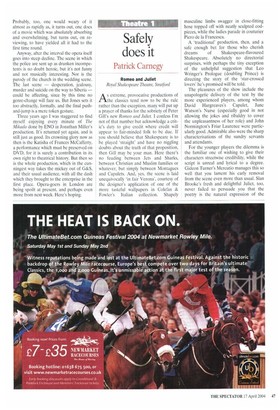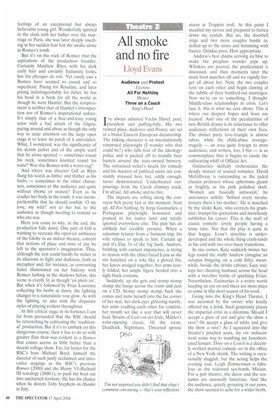Safely does it
Patrick Camegy
Romeo and Juliet Royal Shakespeare Theatre, Stratford
As extreme, provocative productions of the classics tend now to be the rule rather than the exception, many will put up a prayer of thanks for the sobriety of Peter Gill's new Romeo and Juliet. I confess I'm not of that number but acknowledge a critic's duty to give credit where credit will appear to fair-minded folk to be due. If you should believe that Shakespeare is to be played 'straight' and have no niggling doubts about the truth of that proposition, then Gill may be your man. Here there's no feuding between Jets and Sharks, between Christian and Muslim families or whatever, but simply between Montagues and Capulets. And, yes, the scene is laid unequivocally 'in fair Verona', courtesy of the designer's application of one of the more tasteful wallpapers in Colefax & Fowler's Italian collection. Shapely
masculine limbs swagger in close-fitting hose topped off with neatly sculpted codpieces, while the ladies parade in couturier Piero de la Francesca.
A 'traditional' production, then, and a safe enough bet for those who cherish dreams of Shakespeare-flavoured Shakespeare. Absolutely no directorial surprises, with perhaps the tiny exception of the unhelpful suggestion that Leo Wringer's Prologue (doubling Prince) is directing the story of the 'star-crossed lovers' he's promised will be told.
The pleasures of the show include the unapologetic delivery of the text by the more experienced players, among whom David Hargreaves's Capulet, June Watson's Nurse (especially good in not allowing the jokes and ribaldry to cover the unpleasantness of her role) and John Normington's Friar Laurence were particularly good. Admirable also were the sharp characterisations of the sundry servants and attendants.
For the younger players the dilemma is the familiar one of wishing to give their characters streetwise credibility, while the script is unreal and lyrical to a degree. Gideon Turner's Mercutio manages this so well that you lament his early removal from the scene even more than usual, Sian Brooke's fresh and delightful Juliet, too, never failed to persuade you that the poetry is the natural expression of the feelings of an exceptional but always believable young girl. Wonderfully spirited in the clash with her father over the marriage to Paris, she was later deeply touching in her sudden fear lest she awake alone in Romeo's tomb.
But it's on the rock of Romeo that the aspirations of the production founder. Certainly Matthew Rhys, with his dark curly hair and enviably Italianate looks, has the physique du role. Yet rarely can a Romeo have seemed so casual and so superficial. Pining for Rosaline, and later pining indistinguishably for Juliet, he has his head in a book for all the world as though he were Hamlet. But the temperament is neither that of Hamlet's introspection nor of Romeo's inspirational ardour. It's simply that of a free-and-easy young actor with a bad attack of the fidgets, pacing around and about as though the only way to seize attention on the large open stage is to leave no patch of it untrodden. What, I wondered, was the significance of his denim jacket and of the ample scarf that he alone sported — sometimes round his neck, sometimes knotted round his waist? Was this Romeo with a worry-rag?
And where was director Gill as Rhys flung his words as hither and thither as his limbs — sometimes to the other characters, sometimes to the audience and quite without rhyme or reason? Even as he cradles her body in the tomb, it was incomprehensible that he should confide '0 my love, my wife!' not to her but to the audience as though needing to remind us who she was.
Here you come to why, in the end, the production falls down. One part of Gill is wanting to recreate the open-air ambience of the Globe in an indoor theatre, content that notions of place and time of day be left to the spectator's imagination. Thus, although the text could hardly be richer in its allusions to light and darkness, both as metaphor and, for instance, as contrasting Juliet illuminated on her balcony with Romeo lurking in the shadows below, this scene is evenly lit as though 'en plein air'. But when it's followed by Friar Laurence collecting his herbs at dawn, the lighting changes to a naturalistic rosy glow. As with the lighting, so also with the disparate styles of playing evident throughout.
At this critical stage in its fortunes I am far from persuaded that the RSC should be retrenching by cultivating the 'traditional' production. But if it's to embark on this dangerous course, then it has to do so with greater flair than was evident in a Romeo that comes across as little better than a decent college show. Far, far better for the RSC's boss Michael Boyd, himself the director of such justly acclaimed and innovative stagings as the RSC's previous Romeo (2000) and the Henry VI–Richard III tetralogy (2000/1), to push the boat out into uncharted territory. He has his chance when he directs Toby Stephens in Hamlet in July.



































































 Previous page
Previous page